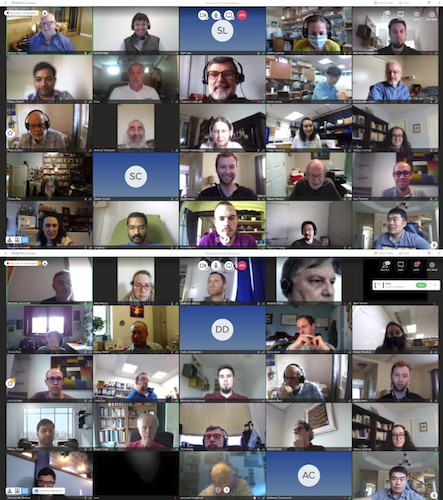
BioCAT held its second MuscleX workshop course from 5/20/21-5/21/21. There were 149 remote participants and 11 speakers, consisting of 3 senior, 4 mid-career, 4 junior level researchers. The workshop was held entirely online, via BlueJeans, with a series of talk followed by general discussions in break-out sessions. The first day started with an introduction to BioCAT by Tom Irving followed by a comprehensive review of the muscle diffraction program at the BioCAT Beamline 18ID by Weikang Ma. The next talk was by Elisabetta Brunello (King’s College London) who described her studies, done at the ESRF in France, of myosin-based regulation mechanisms in rat cardiac muscle, showing among other things important effects of temperature. This was followed by Johan Lindqvist (U. Arizona) who discussed studies, done on 18ID, on mouse skeletal muscle with mutations in nebulin mimicking various forms of nemaline myopathy. Changes in thin filament structure are associated with the force deficits seen in these diseases. Srinivas Chakravarthy (BioCAT/IIT) then talked on the macromolecular SAXS program at BioCAT and how it can be applied to muscle proteins. Raúl Padrón (U. Mass Med.) then described in studies, done on 18ID, on tarantula leg muscles and how the X-ray patterns can be used to interrogate the myosin interacting-heads motifs under various physiological conditions. The Thursday program was wrapped up by Mike Regnier (U Washington) discussing his studies on cardiac and skeletal muscle, done on 18ID, on the changes in myosin structure with 2-deoxy ATP a potential small molecule therapeutic for heart failure. The Thursday program ended by informal discussions in breakout sessions.
The Friday morning section kicked off with a talk by Momcilo Prodanovic (University of Kragujevac, Serbia) on how the multiscale computational modeling package MUSICO can be used to extract more information from X-ray diffraction patterns. Weikang Ma (BioCAT/IIT) followed with a description of the super-relaxed state and length dependent activation in porcine myocardium. Coen Ottenheijm (University of Amsterdam, Medical School) described his studies (done on 18ID) of human diaphragm muscle structural and function deterioration following mechanical ventilation. Massimo Reconditi (University of Florence) discussed his studies (done at 18ID and at the ESRF) on thick filament structure in mouse skeletal muscle as a function of temperature. Finally, Cameron Hill discussed his studies (done at the DIAMOND Light Source) of myosin-based regulation of twitch and tetanic contractions in mammalian skeletal muscle. The speakers and attendees then adjourned to break out rooms for stimulating informal discussions before ending the workshop.
The organizers received numerous congratulations and positive comments from attendees either verbally or though the post-workshop feedback forms. One attendee stated “it was a great workshop with a wide variety of interesting talks across many topics”. We sincerely thank all the attendees who provided feedback and suggestions for improvement and we are looking forward to see you all at MuscleX Workshop 3.